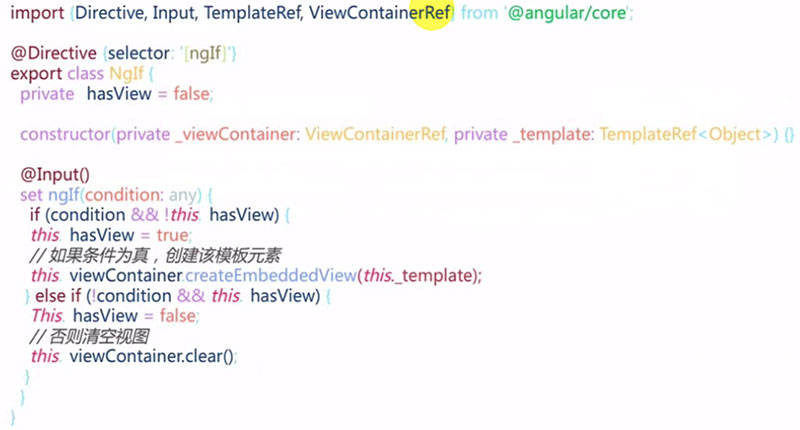这篇文章主要介绍了Angular结构型指令模块和样式的示例分析,具有一定借鉴价值,感兴趣的朋友可以参考下,希望大家阅读完这篇文章之后大有收获,下面让小编带着大家一起了解一下。
一,结构型指令
*是一个语法糖,<a *ngIf="user.login">退出</a>相当于
<ng-template [ngIf]="user.login">
<a>退出</a>
</ng-template>
避免了写ng-template。
<ng-template [ngIf]="item.reminder"> <mat-icon > alarm </mat-icon> </ng-template> <!-- <mat-icon *ngIf="item.reminder"> alarm </mat-icon> -->结构型指令为什么能改变结构?
ngIf源码

set方法标记为@Input,如果条件为真而且不含view的话,把内部hasView标识位置为true然后通过viewContainer根据template创建一个子view。
条件不为真就用视图容器清空所含内容。
viewContainerRef:容器,指令所在的视图的容器
二,模块Module
什么是模块?独立功能的文件集合,用来组织文件。
模块元数据
entryComponents:进入模块就要立刻加载的(比如对话框),而不是调用的时候加载。
exports:模块内部的想要让大家公用,一定要export出来。
forRoot()是什么?
imports: [RouterModule.forRoot(routes)],
imports: [RouterModule.forChild(route)];
其实forRoot和forChild是两个静态工厂方法。
constructor(guard: any, router: Router); static forRoot(routes: Routes, config?: ExtraOptions): ModuleWithProviders<RouterModule>; static forChild(routes: Routes): ModuleWithProviders<RouterModule>;}元数据根据不同情况会变化,元数据没办法动态指定,不写元数据,直接构造一个静态的工程方法,返回一个Module。
写一个forRoot()
创建一个serviceModule:$ ng g m services
import { NgModule } from '@angular/core';import { CommonModule } from '@angular/common';@NgModule({ declarations: [], imports: [ CommonModule ]})export class ServicesModule { }ServiceModule里面的元数据不要了。用一个静态方法forRoot返回。
import { NgModule, ModuleWithProviders } from '@angular/core';import { CommonModule } from '@angular/common';@NgModule()export class ServicesModule { static forRoot(): ModuleWithProviders{ return { ngModule: ServicesModule, providers:[] } }}在core Module中导入的时候使用
imports: [ServicesModule.forRoot();]
三,风格定义
ngClass,ngStyle和[class.yourclass]
ngClass:用于条件动态指定样式类,适合对样式做大量更改的情况。预先定义好class。
<mat-list-item class="container" [@item]="widerPriority" [ngClass]="{ 'priority-normal':item.priority===3, 'priority-important':item.priority===2, 'priority-emergency':item.priority===1}"ngStyle:用于条件动态指定样式,适合少量更改的情况。比如下面例子中[ngStyle]="{'order':list.order}"。key是一个字符串。
[class.yourclass] :[class.yourclass] = "condition"直接对应一个条件。这个condition满足适合应用这个class。等价于ngClass的写法,相当于是ngClass的变体,简写。
<div class="content" mat-line [class.completed]="item.completed"> <span [matTooltip]="item.desc">{{item.desc}}</span></div>使用ngStyle在拖拽的时候调整顺序
原理就是动态指定flex容器样式的order为list模型对象里的order。
在taskHome中给app-task-list添加order
list-container是一个flex容器,它的排列顺序是按照order去排序的。
<app-task-list *ngFor="let list of lists" class="list-container" app-droppable="true" [dropTags]="['task-item','task-list']" [dragEnterClass]=" 'drag-enter' " [app-draggable]="true" [dragTag]=" 'task-list' " [draggedClass]=" 'drag-start' " [dragData]="list" (dropped)="handleMove($event,list)" [ngStyle]="{'order': list.order}" >list数据结构里需要有order,所以增加order属性
lists = [ { id: 1, name: "待办", order: 1, tasks: [ { id: 1, desc: "任务一: 去星巴克买咖啡", completed: true, priority: 3, owner: { id: 1, name: "张三", avatar: "avatars:svg-11" }, dueDate: new Date(), reminder: new Date() }, { id: 2, desc: "任务一: 完成老板布置的PPT作业", completed: false, priority: 2, owner: { id: 2, name: "李四", avatar: "avatars:svg-12" }, dueDate: new Date() } ] }, { id: 2, name: "进行中", order:2, tasks: [ { id: 1, desc: "任务三: 项目代码评审", completed: false, priority: 1, owner: { id: 1, name: "王五", avatar: "avatars:svg-13" }, dueDate: new Date() }, { id: 2, desc: "任务一: 制定项目计划", completed: false, priority: 2, owner: { id: 2, name: "李四", avatar: "avatars:svg-12" }, dueDate: new Date() } ] } ];在list拖拽换顺序的时候,改变order
交换两个srcList和目标list的顺序order
handleMove(srcData,targetList){ switch (srcData.tag) { case 'task-item': console.log('handling item'); break; case 'task-list': console.log('handling list'); const srcList = srcData.data; const tempOrder = srcList.order; srcList.order = targetList.order; targetList.order = tempOrder; default: break; } }感谢你能够认真阅读完这篇文章,希望小编分享的“Angular结构型指令模块和样式的示例分析”这篇文章对大家有帮助,同时也希望大家多多支持编程网,关注编程网行业资讯频道,更多相关知识等着你来学习!




